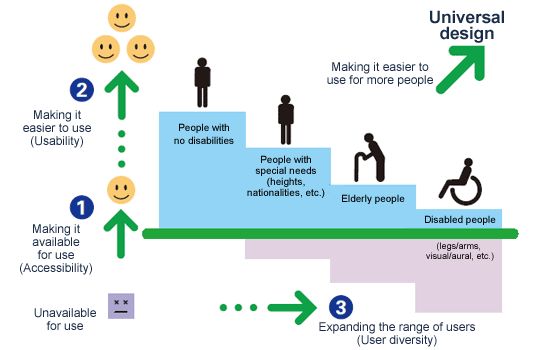“Although it’s clear that people with disabilities are ignored and forgotten in times of crisis, there’s little empirical evidence on the kind of tools needed to provide the best care.”
– Samantha Cowan, TakePart.com, “One Group Empowers People With Disabilities to Weather Any Storm,” via Yahoo News

Universal Design, from access.ecs.soton.ac.uk
Picture the scene: A tornado is headed your way, and you’re driving on a flat road. An overpass is in sight. So is a ditch. What do you do? Do you run to safety? But what if you can’t run? What if you’re alone at home, in the path of the tornado, and have no way of hearing or seeing tornado warnings?
These basic – yet powerful – examples underscore the need for inclusive or universal design-oriented thinking, most evident in the design of contemporary fire alarms (with both sound and sight functionalities), and street lights (with sound, sight, and tactile functionalities) that serve as indicators for people with disabilities.
Prior to attending a lecture last week by Professor Chi Kim, a specialist on assistive music technology at the Berklee College of Music, I hadn’t given much thought to the importance of Universal Design – or the importance of creating multi-sensory solutions. Then, after reading Cowan’s article (linked above), I realized that I had also never thought of the challenges people with disabilities faces during a natural disaster, and by extension, the devastating impact of sudden or chronic natural disasters on people with disabilities worldwide. From monsoons to earthquakes to avalanches, Cowan writes, “Some families find it easier to just abandon the [people with disabilities] during disasters than trying to bring them along.” But what about political, social, or economic crises?

If this is the history of design, what does the future of design look like? History of Design, from livewellcollaborative.org.
Our projects require that we think about ‘environmental’ context and the sustainability of design for both product and user, among others. But I can’t help but think of how our “solutions” would be influenced by variables faced by people with disabilities across the world…or even outside of Boston. Variables I didn’t even begin to consider until last Friday.
I have immense respect for the countless engineers and designers and product managers (etc etc) that have enabled and empowered their users to lead more independent lives. I’ve only now begun to think this way, but I’m grateful for the opportunity to continue learning about assistive technology, the importance of universal design, and how these interact with built, social, and natural environments.
You bring up an excellent point with the response to natural disasters- I honestly hadn’t thought about this either. I wonder if the increased rate at which we are seeing catastrophic weather events will focus more attention on the issue. It’s also important to remember that it doesn’t have to be an extraordinary event that presents these issues. Something as trivial (by most people’s standards) as a few inches of un-shoveled snow on a sidewalk can be hugely disruptive to a wheelchair user or blind person. Thanks for making me think.